Soil salinity is a serious global problem that threatens a high percentage of the global soils. Salinity stress can create ionic, oxidative, and osmotic stress, along with hormonal imbalances, in stressful plants. Application of nanomaterials for ameliorating salinity stress has gained great attention due to their high efficiency, eco-friendliness, and non-toxicity, especially biological nanomaterials. The application of NMs did not only support growing stressful plants under salinity stress but also increased the yield of crops, provided an economically feasible nutrient management approach, and was environmentally robust for sustainable crop productivity. Nano-management of salinity may involve applying traditional nano-amendments, biological nanomaterials, nano-enabled nutrients, nano-organic amendments, derived smart nanostructures, and nano-tolerant plant cultivars.
- nano-gypsum
- nanoparticles
- nanotoxicity nanofarming
- plant growth regulators
- salt stress
1. Introduction
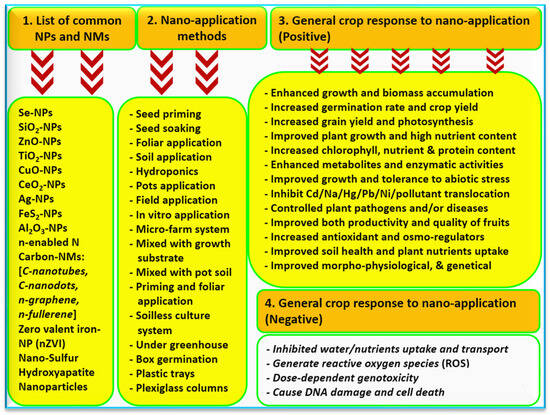
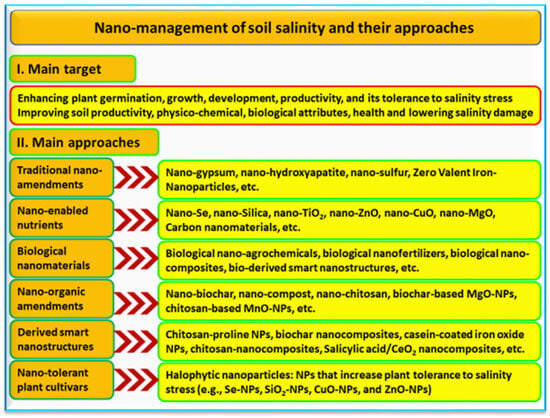
2. Nano-Management of Farming under Salinity Stress
2.1. Nano-Agrochemicals
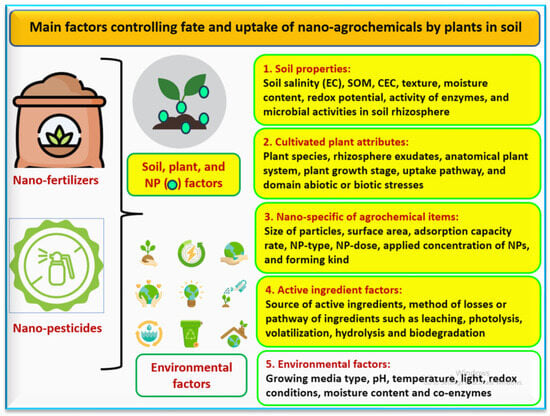
2.2. Nano-Soil Amendments
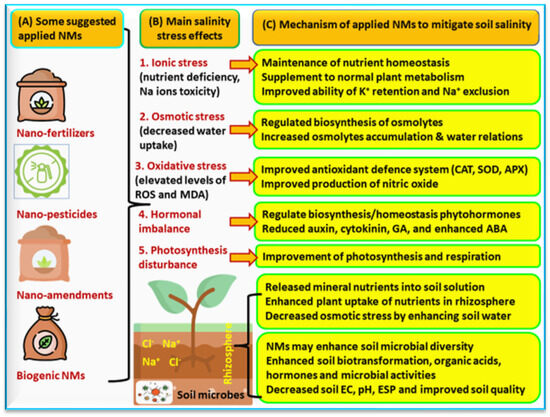
2.3. Biogenic Nanomaterials
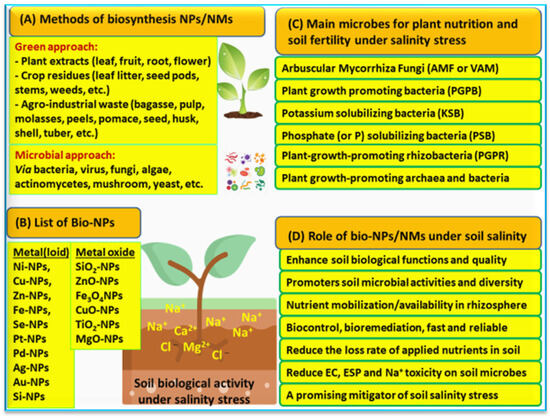
2.4. Nanocomposites
2.5. In Vitro Nano-Management
3. Nano-Management under Toxicity Conditions

This entry is adapted from the peer-reviewed paper 10.3390/agronomy13112695
References
- Seleiman, M.F.; Almutairi, K.F.; Alotaibi, M.; Shami, A.; Alhammad, B.A.; Battaglia, M.L. Nano-Fertilization as an Emerging Fertilization Technique: Why Can Modern Agriculture Benefit from Its Use? Plants 2021, 10, 2.
- hardwaj, A.K.; Arya, G.; Kumar, R.; Hamed, L.; Pirasteh-Anosheh, H.; Jasrotia, P.; Kashyap, P.L.; Singh, G.P. Switching to nanonutrients for sustaining agroecosystems and environment: The challenges and benefits in moving up from ionic to particle feeding. J. Nanobiotechnology 2022, 20, 19.
- Gangwar, J.; Sebastian, J.K.; Jaison, J.P.; Kurian, J.T. Nano-technological interventions in crop production—A review. Physiol. Mol. Biol. Plants 2023, 29, 93–107.
- Konappa, N.; Krishnamurthy, S.; Arakere, U.C.; Chowdappa, S.; Akbarbasha, R.; Ramachandrappa, N.S. Nanofertilizers and nanopesticides: Recent trends, future prospects in agriculture. In Advances in Nano-Fertilizers and Nano-Pesticides in Agriculture; Elsevier: Amsterdam, The Netherlands, 2021; pp. 281–330.
- El-Ramady, H.; Abdalla, N.; Sári, D.; Ferroudj, A.; Muthu, A.; Prokisch, J.; Fawzy, Z.F.; Brevik, E.C.; Solberg, S.Ø. Nanofarming: Promising Solutions for the Future of the Global Agricultural Industry. Agronomy 2023, 13, 1600.
- Munir, N.; Hanif, M.; Dias, D.A.; Abideen, Z. The role of halophytic nanoparticles towards the remediation of degraded and saline agricultural lands. Environ. Sci. Pollut. Res. Int. 2021, 28, 60383–60405.
- Sahab, S.; Suhani, I.; Srivastava, V.; Chauhan, P.S.; Singh, R.P.; Prasad, V. Potential risk assessment of soil salinity to agroecosystem sustainability: Current status and management strategies. Sci. Total Environ. 2021, 764, 144164.
- Navarro-Torre, S.; Aguilera-Salas, M.; Ávila-Pozo, P.; Parrado, J.; Tejada, M. Study of the biochemical activity and plant growth promoting bacteria in soils polluted with oxyfluorfen. Cogent Food Agric. 2023, 9, 2247171.
- Alhammad, B.A.; Abdel-Aziz, H.M.M.; Seleiman, M.F.; Tourky, S.M.N. How Can Biological and Chemical Silver Nanoparticles Positively Impact Physio-Chemical and Chloroplast Ultrastructural Characteristics of Vicia faba Seedlings? Plants 2023, 12, 2509.
- Alhammad, B.A.; Ahmad, A.; Seleiman, M.F. Nano-Hydroxyapatite and ZnO-NPs Mitigate Pb Stress in Maize. Agronomy 2023, 13, 1174.
- Al-Selwey, W.A.; Alsadon, A.A.; Alenazi, M.M.; Tarroum, M.; Ibrahim, A.A.; Ahmad, A.; Osman, M.; Seleiman, M.F. Morphological and Biochemical Response of Potatoes to Exogenous Application of ZnO and SiO2 Nanoparticles in a Water Deficit Environment. Horticulturae 2023, 9, 883.
- Ahmad, A.; Tola, E.; Alshahrani, T.S.; Seleiman, M.F. Enhancement of Morphological and Physiological Performance of Zea mays L. under Saline Stress Using ZnO Nanoparticles and 24-Epibrassinolide Seed Priming. Agronomy 2023, 13, 771.
- Shafiq, F.; Iqbal, M.; Raza, S.H.; Akram, N.A.; Ashraf, M. Fullerenol Nano-cages for Protection of Crops Against Oxidative Stress: A Critical Review. J. Plant Growth Regul. 2023, 42, 1267–1290.
- Baazaoui, N.; Bellili, K.; Messaoud, M.; Elleuch, L.; Elleuch, R.; Labidi, S.; Aounallah, K.; Maazoun, A.; Salhi, R.; Shati, A.A.; et al. Bio-nano-remediation of Olive Oil Mill Wastewater using Silicon Dioxide Nanoparticles for Its Potential Use as Biofertilizer for Young Olive Plants. Silicon 2023, 1–17.
- El-Saadony, M.T.; Desoky, E.M.; Saad, A.M.; Eid, R.S.M.; Selem, E.; Elrys, A.S. Biological silicon nanoparticles improve Phaseolus vulgaris L. yield and minimize its contaminant contents on a heavy metals-contaminated saline soil. J. Environ. Sci. 2021, 106, 1–14.
- Ghazi, A.A.; El-Nahrawy, S.; El-Ramady, H.; Ling, W. Biosynthesis of Nano-Selenium and Its Impact on Germination of Wheat under Salt Stress for Sustainable Production. Sustainability 2022, 14, 1784.
- Zhang, Y.; Goss, G.G. Nanotechnology in agriculture: Comparison of the toxicity between conventional and nano-based agrochemicals on non-target aquatic species. J. Hazard. Mater. 2022, 439, 129559.
- Grillo, R.; Fraceto, L.F.; Amorim, M.J.B.; Scott-Fordsmand, J.J.; Schoonjans, R.; Chaudhry, Q. Ecotoxicological and regulatory aspects of environmental sustainability of nanopesticides. J. Hazard. Mater. 2021, 404 Pt A, 124148.
- Ahmed, T.; Noman, M.; Gardea-Torresdey, J.L.; White, J.C.; Li, B. Dynamic interplay between nano-enabled agrochemicals and the plant-associated microbiome. Trend Plant Sci. 2023.
- Sharma, S.; Kumar, A.; Choudhary, A.; Harish, B.M.; Karmakar, P.; Sharma, P.; Singh, J.; Pandey, V.; Mehta, S. Recent developments in smart nano-agrochemicals: A promise for revolutionizing present-day agriculture. Mater. Today Proc. 2022, 69 Pt 2, 530–534.
- He, J.; Li, J.; Gao, Y.; He, X.; Hao, G. Nano-based smart formulations: A potential solution to the hazardous effects of pesticide on the environment. J. Hazard. Mater. 2023, 456, 131599.
- Aiad, M.A.; Amer, M.M.; Khalifa, T.H.H.; Shabana, M.M.A.; Zoghdan, M.G.; Shaker, E.M.; Eid, M.S.M.; Ammar, K.A.; Al-Dhumri, S.A.; Kheir, A.M.S. Combined Application of Compost, Zeolite and a Raised Bed Planting Method Alleviate Salinity Stress and Improve Cereal Crop Productivity in Arid Regions. Agronomy 2021, 11, 2495.
- Okeke, E.S.; Ezeorba, T.P.C.; Mao, G.; Chen, Y.; Feng, W.; Wu, X. Nano-enabled agrochemicals/materials: Potential human health impact, risk assessment, management strategies and future prospects. Environ. Pollut. 2022, 295, 118722.
- Rani, N.; Duhan, A.; Pal, A.; Kumari, P.; Beniwal, R.K.; Verma, D.; Goyat, A.; Singh, R. Are nano-pesticides really meant for cleaner production? An overview on recent developments, benefits, environmental hazards and future prospectives. J. Clean. Prod. 2023, 411, 137232.
- Yin, J.; Su, X.; Yan, S.; Shen, J. Multifunctional Nanoparticles and Nanopesticides in Agricultural Application. Nanomaterials 2023, 13, 1255.
- Shen, M.; Liu, S.; Jiang, C.; Zhang, T.; Chen, W. Recent advances in stimuli-response mechanisms of nano-enabled controlled-release fertilizers and pesticides. Eco-Env. Health 2023, 2, 161–175.
- Jha, A.; Pathania, D.; Sonu, D.B.; Raizada, P.; Rustagi, S.; Singh, P.; Rani, G.M.; Chaudhary, V. Panorama of biogenic nano-fertilizers: A road to sustainable agriculture. Environ. Res. 2023, 235, 116456.
- Guo, H.; White, J.C.; Wang, Z.; Xing, B. Nano-enabled fertilizers to control the release and use efficiency of nutrients. Curr. Opin. Environ. Sci. Health 2018, 6, 77–83.
- Yadav, A.; Yadav, K.; Abd-Elsalam, K.A. Nanofertilizers: Types, Delivery and Advantages in Agricultural Sustainability. Agrochemicals 2023, 2, 296–336.
- Muhammad, H.M.D.; Abbas, A.; Ahmad, R. Fascinating Role of Silicon Nanoparticles to Mitigate Adverse Effects of Salinity in Fruit Trees: A Mechanistic Approach. Silicon 2022, 14, 8319–8326.
- El-Badri, A.M.; Hashem, A.M.; Batool, M.; Sherif, A.; Nishawy, E.; Ayaad, M.; Hassan, H.M.; Elrewainy, I.M.; Wang, J.; Kuai, J.; et al. Comparative efficacy of bio-selenium nanoparticles and sodium selenite on morpho-physiochemical attributes under normal and salt stress conditions, besides selenium detoxification pathways in Brassica napus L. J. Nanobiotechnology 2022, 20, 163.
- Song, Y.; Zheng, C.; Li, S.; Chen, J.; Jiang, M. Chitosan-Magnesium Oxide Nanoparticles Improve Salinity Tolerance in Rice (Oryza sativa L.). ACS Appl. Mater. Interfaces 2023, 15, 20649–20660.
- Ding, Z.; Zhao, F.; Zhu, Z.; Ali, E.F.; Shaheen, S.M.; Rinklebe, J.; Eissa, M.A. Green nanosilica enhanced the salt-tolerance defenses and yield of Williams banana: A field trial for using saline water in low fertile arid soil. Environ. Exp. Bot. 2022, 197, 104843.
- Abdalla, H.; Adarosy, M.H.; Hegazy, H.S.; Abdelhameed, R.E. Potential of green synthesized titanium dioxide nanoparticles for enhancing seedling emergence, vigor and tolerance indices and DPPH free radical scavenging in two varieties of soybean under salinity stress. BMC Plant Biol. 2022, 22, 560.
- Sarkar, R.D.; Kalita, M.C. Se nanoparticles stabilized with Allamanda cathartica L. flower extract inhibited phytopathogens and promoted mustard growth under salt stress. Heliyon 2022, 8, e09076.
- Shelar, A.; Nile, S.H.; Singh, A.V.; Rothenstein, D.; Bill, J.; Xiao, J.; Chaskar, M.; Kai, G.; Patil, R. Recent Advances in Nano-Enabled Seed Treatment Strategies for Sustainable Agriculture: Challenges, Risk Assessment, and Future Perspectives. Nano-Micro Lett. 2023, 15, 54.
- Patle, T.; Sharma, S.K. Synthesis of nano-gypsum: A computational approach to encounter soil salinity and land degradation. Comput. Theor. Chem. 2022, 1217, 113909.
- Arora, S. Diagnostic Properties and Constraints of Salt-Affected Soils. In Bioremediation of Salt Affected Soils: An Indian Perspective; Springer International Publishing AG: Berlin/Heidelberg, Germany, 2017.
- Arora, S.; Singh, A.K.; Singh, Y.P. Bioremediation of Salt Affected Soils: An Indian Perspective; Springer-International Publishing AG: Berlin/Heidelberg, Germany, 2017.
- El-Ramady, H.; Abowaly, M.; Elbehiry, F.; Omara, A.E.-D.; Elsakhawy, T.; Mohamed, E.S.; Belal, A.; Elbasiouny, H.; Fawzy, Z.F. Stressful Environments and Sustainable Soil Management: A Case Study of Kafr El-Sheikh, Egypt. Environ. Biodiv. Soil Secur. 2019, 3, 193–213.
- Salama, A.M.; El-Halim, A.E.-H.A.A.; Ibrahim, M.M.; Aiad, M.A.; El-Shal, R.M. Amendment with Nanoparticulate Gypsum Enhances Spinach Growth in Saline-Sodic Soil. J. Soil Sci. Plant Nutr. 2022, 22, 3377–3385.
- Balusamy, S.R.; Rahimi, S.; Sukweenadhi, J.; Sunderraj, S.; Shanmugam, R.; Thangavelu, L.; Mijakovic, I.; Perumalsamy, H. Chitosan, chitosan nanoparticles and modified chitosan biomaterials, a potential tool to combat salinity stress in plants. Carbohydr. Polym. 2022, 284, 119189.
- Hidangmayum, A.; Dwivedi, P. Chitosan Based Nanoformulation for Sustainable Agriculture with Special Reference to Abiotic Stress: A Review. J. Polym. Environ. 2022, 30, 1264–1283.
- Hoque, M.N.; Imran, S.; Hannan, A.; Paul, N.C.; Mahamud, M.A.; Chakrobortty, J.; Sarker, P.; Irin, I.J.; Brestic, M.; Rhaman, M.S. Organic Amendments for Mitigation of Salinity Stress in Plants: A Review. Life 2022, 12, 1632.
- Giannelli, G.; Potestio, S.; Visioli, G. The Contribution of PGPR in Salt Stress Tolerance in Crops: Unravelling the Molecular Mechanisms of Cross-Talk between Plant and Bacteria. Plants 2023, 12, 2197.
- Duan, M.; Yan, R.; Wang, Q.; Zhou, B.; Zhu, H.; Liu, G.; Guo, X.; Zhang, Z. Integrated microbiological and metabolomics analyses to understand the mechanism that allows modified biochar to affect the alkalinity of saline soil and winter wheat growth. Sci. Total Environ. 2023, 866, 161330.
- Rajput, V.D.; Minkina, T.; Ahmed, B.; Singh, V.K.; Mandzhieva, S.; Sushkova, S.; Bauer, T.; Verma, K.K.; Shan, S.; van Hullebusch, E.D.; et al. Nano-biochar: A novel solution for sustainable agriculture and environmental remediation. Environ. Res. 2022, 210, 112891.
- Li, Z.; Zhu, L.; Zhao, F.; Li, J.; Zhang, X.; Kong, X.; Wu, H.; Zhang, Z. Plant Salinity Stress Response and Nano-Enabled Plant Salt Tolerance. Front. Plant Sci. 2022, 13, 843994.
- Wu, Y.; Wang, X.; Zhang, L.; Zheng, Y.; Liu, X.; Zhang, Y. The critical role of biochar to mitigate the adverse impacts of drought and salinity stress in plants. Front. Plant Sci. 2023, 14, 1163451.
- El-Ghamry, A.M.; Mosa, A.A.; Alshaal, T.A.; ElRamady, H.R. Nanofertilizers vs. Biofertilizers: New Insights. Environ. Biodiv. Soil Secur. 2018, 2, 51–72.
- Shalaby, T.A.; Bayoumi, Y.; Eid, Y.; Elbasiouny, H.; Elbehiry, F.; Prokisch, J.; El-Ramady, H.; Ling, W. Can Nanofertilizers Mitigate Multiple Environmental Stresses for Higher Crop Productivity? Sustainability 2022, 14, 3480.
- Abdel-Rahman, H.M.; Zaghloul, R.A.; Enas, A.; Hassan, H.R.A.; El-Zehery, A.A.; Salem, A.A. New Strains of Plant Growth-Promoting Rhizobacteria in Combinations with Humic Acid to Enhance Squash Growth under Saline Stress. Egypt. J. Soil. Sci. 2021, 61, 129–146.
- Neshat, M.; Abbasi, A.; Hosseinzadeh, A.; Sarikhani, M.R.; Chavan, D.D.; Rasoulnia, A. Plant growth promoting bacteria (PGPR) induce antioxidant tolerance against salinity stress through biochemical and physiological mechanisms. Physiol. Mol. Biol. Plants 2022, 28, 347–361.
- Abd-Elzaher, M.A.; El-Desoky, M.A.; Khalil, F.A.; Eissa, M.E.; Amin, A.E.A. Interactive Effects of K-Humate, Proline and Si and Zn Nanoparticles in Improving Salt Tolerance of Wheat in Arid Degraded Soils. Egypt. J. Soil Sci. 2022, 62, 237–251.
- Aazami, M.A.; Rasouli, F.; Ebrahimzadeh, A. Oxidative damage, antioxidant mechanism and gene expression in tomato responding to salinity stress under in vitro conditions and application of iron and zinc oxide nanoparticles on callus induction and plant regeneration. BMC Plant Biol. 2021, 21, 597.
- Ha-Tran, D.M.; Nguyen, T.T.M.; Hung, S.H.; Huang, E.; Huang, C.C. Roles of Plant Growth-Promoting Rhizobacteria (PGPR) in Stimulating Salinity Stress Defense in Plants: A Review. Int. J. Mol. Sci. 2021, 22, 3154.
- Shultana, R.; Zuan, A.T.K.; Naher, U.A.; Islam, A.K.M.M.; Rana, M.M.; Rashid, M.H.; Irin, I.J.; Islam, S.S.; Rim, A.A.; Hasan, A.K. The PGPR Mechanisms of Salt Stress Adaptation and Plant Growth Promotion. Agronomy 2022, 12, 2266.
- Sambangi, P.; Gopalakrishnan, S.; Pebam, M.; Rengan, A.K. Nano-biofertilizers on soil health, chemistry, and microbial community: Benefits and risks. Proc. Indian Natl. Sci. Acad. 2022, 88, 357–368.
- Chaudhary, V.; Rustagi, S.; Kaushik, A. Bio-derived smart nanostructures for efficient biosensors. Curr. Opin. Green Sustain. Chem. 2023, 42, 100817.
- Tolisano, C.; Del Buono, D. Biobased: Biostimulants and biogenic nanoparticles enter the scene. Sci. Total Environ. 2023, 885, 163912.
- Dhlamini, B.; Paumo, H.K.; Kamdem, B.P.; Katata-Seru, L.; Bahadur, I. Nano-engineering metal-based fertilizers using biopolymers: An innovative strategy for a more sustainable agriculture. J. Environ. Chem. Eng. 2022, 10, 107729.
- Sharma, B.; Tiwari, S.; Kumawat, K.C.; Cardinale, M. Nano-biofertilizers as bio-emerging strategies for sustainable agriculture development: Potentiality and their limitations. Sci. Total Environ. 2023, 860, 160476.
- Chakraborty, R.; Mukhopadhyay, A.; Paul, S.; Sarkar, S.; Mukhopadhyay, R. Nanocomposite-based smart fertilizers: A boon to agricultural and environmental sustainability. Sci. Total. Environ. 2023, 863, 160859.
- Burvey, P.; Jain, P.; Singh, A. Strategic role of casein coated iron oxide nano-particles for delivering nano nutrients for enhance soil quality and their potential. Mater. Today Proc. 2023, 89, 96–105.
- Mirzaee, E.; Sartaj, M. Remediation of PAH-contaminated soil using a combined process of soil washing and adsorption by nano iron oxide/granular activated carbon composite. Environ. Nanotechnol. Monit. Manag. 2023, 20, 100800.
- Wypij, M.; Trzcińska-Wencel, J.; Golińska, P.; Avila-Quezada, G.D.; Ingle, A.P.; Rai, M. The strategic applications of natural polymer nanocomposites in food packaging and agriculture: Chances, challenges, and consumers’ perception. Front. Chem. 2023, 10, 1106230.
- Yang, J.; Han, X.; Yang, W.; Hu, J.; Zhang, C.; Liu, K.; Jiang, S. Nanocellulose-based composite aerogels toward the environmental protection: Preparation, modification and applications. Environ. Res. 2023, 236 Pt 1, 116736.
- Haydar, S.; Ali, S.; Mandal, P.; Roy, D.; Roy, M.N.; Kundu, S.; Kundu, S.; Choudhuri, C. Fe–Mn nanocomposites doped graphene quantum dots alleviate salt stress of Triticum aestivum through osmolyte accumulation and antioxidant defense. Sci. Rep. 2023, 13, 11040.
- Zaki, F.S.; Khater, M.A.; El-Awadi, M.E.; Dawood, M.G.; Elsayed, A.E. Curcumin-polyvinyl alcohol nano-composite enhances tolerance of Helianthus annuus L. against salinity stress. Beni-Suef Univ. J. Basic Appl. Sci. 2023, 12, 60.
- Farhangi-Abriz, S.; Ghassemi-Golezani, K. Changes in soil properties and salt tolerance of safflower in response to biochar-based metal oxide nanocomposites of magnesium and manganese. Ecotoxicol. Environ. Safety 2021, 211, 111904.
- Rahimzadeh, S.; Ghassemi-Golezani, K. Biochar-Based Nutritional Nanocomposites Altered Nutrient Uptake and Vacuolar H+-Pump Activities of Dill Under Salinity. J. Soil Sci. Plant Nutr. 2022, 22, 3568–3581.
- Hajihashemi, S.; Kazemi, S. The potential of foliar application of nano-chitosan-encapsulated nano-silicon donor in amelioration the adverse effect of salinity in the wheat plant. BMC Plant Biol. 2022, 22, 148.
- Al Hinai, M.S.; Ullah, A.; Al-Toubi, A.-K.M.; Al Harrasi, I.R.; Alamri, A.A.; Farooq, M. Co-application of Biochar and Seed Priming with Nano-sized Chitosan-Proline Improves Salt Tolerance in Differentially Responding Bread Wheat Genotypes. J. Soil Sci. Plant Nutr. 2023, 23, 1–16.
- Aazami, M.A.; Maleki, M.; Rasouli, F.; Gohari, G. Protective effects of chitosan based salicylic acid nanocomposite (CS-SA NCs) in grape (Vitis vinifera cv. ‘Sultana’) under salinity stress. Sci. Rep. 2023, 13, 883.
- Ingle, P.U.; Shende, S.S.; Shingote, P.R.; Mishra, S.S.; Sarda, V.; Wasule, D.L.; Rajput, V.D.; Minkina, T.; Rai, M.; Sushkova, S.; et al. Chitosan nanoparticles (ChNPs): A versatile growth promoter in modern agricultural production. Heliyon 2022, 8, e11893.
- Mohan, M.F.; Praseetha, P.N. Prospects of Biopolymers Based Nanocomposites for the Slow and Controlled Release of Agrochemicals Formulations. J. Inorg. Organomet. Polym. 2023, 1–16.
- Mozafari, A.; Ghadakchi asl, A.; Ghaderi, N. Grape response to salinity stress and role of iron nanoparticle and potassium silicate to mitigate salt induced damage under in vitro conditions. Physiol. Mol. Biol. Plants 2018, 24, 25–35.
- Mozafari, A.; Dedejani, S.; Ghaderi, N. Positive responses of strawberry (Fragaria × ananassa Duch.) explants to salicylic and iron nanoparticle application under salinity conditions. Plant Cell Tissue Organ Cult. 2018, 134, 267–275.
- Hanif, S.; Sajjad, A.; Javed, R.; Mannan, A.; Zia, M. Proline doped ZnO nanocomposite alleviates NaCl induced adverse effects on morpho-biochemical response in Coriandrum sativum. Plant Stress 2023, 9, 100173.
- Mahmoud, E.; El Baroudy, A.; Ali, N.; Sleem, M. Spectroscopic studies on the phosphorus adsorption in salt-affected soils with or without nano-biochar additions. Environ. Res. 2020, 184, 109277.
- Hanif, S.; Zia, M. Glycine betaine capped ZnO NPs eliminate oxidative stress to coriander plants grown under NaCl presence. Plant Physiol. Biochem. 2023, 197, 107651.
- Murali, M.; Gowtham, H.G.; Brijesh, S.; Shilpa, S.N.; Aiyaz, M.; Alomary, M.N.; Alshamrani, M.; Salawi, A.; Almoshari, Y.; Ansari, M.A.; et al. Fate, bioaccumulation and toxicity of engineered nanomaterials in plants: Current challenges and future prospects. Sci. Total Environ. 2022, 811, 152249.
- Mathur, P.; Chakraborty, R.; Aftab, T.; Roy, S. Engineered nanoparticles in plant growth: Phytotoxicity concerns and the strategies for their attenuation. Plant Physiol. Biochem. 2023, 199, 107721.
- Oliveira, H.C.; Seabra, A.B.; Kondak, S.; Adedokun, O.P.; Kolbert, Z. Multilevel approach to plant–nanomaterial relationships: From cells to living ecosystems. J. Exper. Bot. 2023, 74, 3406–3424.
- Chanu, N.B.; Alice, A.K.; Thokchom, A.; Singh, M.C.; Chanu, N.T.; Singh, Y.D. Engineered nanomaterial and their interactions with plant–soil system: A developmental journey and opposing facts. Nanotechnol. Environ. Eng. 2021, 6, 36.
- Sukul, U.; Das, K.; Chen, J.S.; Sharma, R.K.; Dey, G.; Banerjee, P.; Taharia, M.; Lee, C.-I.; Maity, J.P.; Lin, P.Y.; et al. Insight interactions of engineered nanoparticles with aquatic higher plants for phytoaccumulation, phytotoxicity, and phytoremediation applications: A review. Aquat. Toxicol. 2023, 264, 106713.
- Sun, Y.; Jing, R.; Zheng, F.; Zhang, S.; Jiao, W.; Wang, F. Evaluating phytotoxicity of bare and starch-stabilized zero-valent iron nanoparticles in mung bean. Chemosphere 2019, 236, 124336.
- Ma, X.; Gurung, A.; Deng, Y. Phytotoxicity and uptake of nanoscale zero-valent iron (nZVI) by two plant species. Sci. Total Environ. 2013, 443, 844–849.
- Shakoor, N.; Adeel, M.; Nadeem, M.; Abdullah Aziz, M.; Zain, M.; Hussain, M.; Azeem, I.; Xu, M.; Ahmad, M.A.; Rui, Y. Exploring the Effects of Iron Nanoparticles on Plants: Growth, Phytotoxicity, and Defense Mechanisms. In Nanomaterials and Nanocomposites Exposures to Plants, Smart Nanomaterials Technology; Husen, A., Ed.; Springer Nature: Singapore, 2023; pp. 209–226.
- Shah, G.M.; Amin, M.; Shahid, M.; Ahmad, I.; Khalid, S.; Abbas, G.; Imran, M.; Naeem, M.A.; Shahid, N. Toxicity of ZnO and Fe2O3 nano-agro-chemicals to soil microbial activities, nitrogen utilization, and associated human health risks. Environ. Sci. Eur. 2022, 34, 106.
- Jam, B.J.; Shekari, F.; Andalibi, B.; Fotovat, R.; Jafarian, V.; Dolatabadian, A. The Effects of Salicylic Acid and Silicon on Safflower Seed Yield, Oil Content, and Fatty Acids Composition under Salinity Stress. Silicon 2023, 15, 4081–4094.
- Singh, P.; Arif, Y.; Siddiqui, H.; Sami, F.; Zaidi, R.; Azam, A.; Alam, P.; Hayat, S. Nanoparticles enhances the salinity toxicity tolerance in Linum usitatissimum L. by modulating the antioxidative enzymes, photosynthetic efficiency, redox status and cellular damage. Ecotoxicol. Environ. Saf. 2021, 213, 112020.
